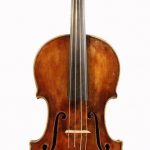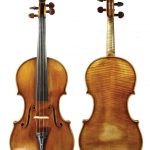Alberto Giordano takes a closer look at the 1708 ‘Dancla’ Stradivari, a model that perfectly represents some of the maker’s later experiments but also features some rare characteristics.
The turn of the 18th century brought an era of great change to Italy, which had been under Spanish rule since the mid-16th century. The death in 1700 of the last Habsburg king of Spain, the childless Charles II, prompted the War of the
Spanish Succession, and Italy once again turned into a battlefield for the Austrian, French and Spanish armies. Owing to its strategic position, Cremona came under French occupation as early as 1701, and although the occupation of northern Italy in general wasn’t over until 1713, Cremona was freed from the Franco–Spanish alliance and passed under the control of Habsburg Austria in April 1707. During this period, not only did Italians have to face the violence of war and the difficulties of hosting foreign soldiers, but also they were expected to pay higher taxes. The whole affair inevitably resulted in a period of general economic stagnation. However, the violin trade in Cremona seems to have been resistant to the unfavourable conditions, and Antonio Stradivari’s workshop took a leading role. What George Hart termed the Stradivari ‘golden period’ began in 1700, and notwithstanding a reduction in the workshop’s output 1705–6 (probably due to the above- mentioned conditions), production began to rise consistently from 1708, the year in which the ‘Dancla’ was made. Stradivari was in his sixties, Francesco in his thirties and Omobono in his late twenties, and the workshop was firing on all cylinders with Stradivari still trying new things. It’s not ideal to try to place periods of Stradivari’s creativity into neat boxes, for his work appears to demonstrate that he was constantly innovating and questioning his own ideas. In examining this evolution, we must take into account the important experiments he undertook during the 1690s, when he produced a number of long pattern violins that were, according to the Hills, inspired by the work of Giovanni Paolo Maggini. At the beginning of the new century he reverted to a more Amati-oriented style, a kind of return to the classic inspiration of his younger period; but around 1708 he changed tack again, bringing himself back towards a bolder idea of what a violin should be. Stradivari’s experiments with proportions, rib heights and string lengths resulted in a form of large dimensions, with a back length of nearly 360mm, that was characterised by full curves in both front and back plates. These stylistic alterations were probably made for both aesthetic and functional reasons: on the one hand, Stradivari seems to have been aiming for a strong-looking violin with well-defined arching and scroll, refined by delicate edgework and perfectly balanced f-holes; on the other, he appears to have been looking for a more powerful sound, with a deeper bass complemented by a bright, silvery treble tone on the E string. The ‘Dancla’ violin is a perfect example of this model, representing the new horizons that an aged Stradivari was still exploring. In a 1913 letter from the Parisian luthiers Caressa & Français to Arthur Spitzer, the ‘Dancla’ Stradivari violin is described as ‘fully authentic, totally guaranteed and in a remarkable state of conservation’. The sellers also wrote of the instrument’s provenance since its first known owner, one Mr Defrance from Saint-Étienne, who is reported to have bought it in Paris in 1854 from Jean-Baptiste Vuillaume. Nothing is known about the instrument prior to this.
According to recent research by Duane Rosengard, the ‘Dancla’ was first recorded in 1870 in a notebook belonging to Charles-Nicolas-Eugène Gand, who listed it for his private use among some two hundred violins, violas and cellos made
by Stradivari and Guarneri ‘del Gesù’. It then passed through various hands until 1882, when it was acquired from Émile Germain by Charles Dancla, a professor of violin at the Paris Conservatoire, who had decided to enrich his collection by purchasing his third Strad violin. Dancla kept it until 1903, when he sold it to Albert Caressa, who in turn passed it to Édouard Nadaud, a pupil of Dancla who himself became professor of violin at the conservatoire. When Nadaud retired in 1912, the violin was reconsigned to Caressa & Français. The next owner was Colonel Maitre of Sedan, but he exchanged it for the ‘Chant du Cygne’ Stradivari, leaving the ‘Dancla’ to fall into the hands of the young violinist Spitzer.
According to Charles Beare’s certification, the 1708 ‘Dancla’ still bears the original label. The instrument is in fine condition today. The back is made of a beautiful single piece of maple with an almost horizontal flame that is quite deep and regularly disposed all along the plate. During this period Stradivari had a preference for one-piece backs, and many of his violins of the time were made from stunning pieces taken from one of two maple logs – one of a large and deep flame and the other with a narrower flame. It is the latter type that he used for the ‘Dancla’, as well as, for example, for the 1707 ‘La Cathédrale’ and the 1709 ‘Engleman’.
The archings are consistent in height and curve in a violin of strong visual impact – a powerful, bold look for which Stradivari was striving from the turn of the century, especially from 1707. The height of the back rises to almost 18mm, and the curves remain full right up to the edges. On the profile, the curves descend slowly from the corner-block lines towards the end-blocks; on the C-bouts, the arching stays full nearly all the way up to the purfling, lending an appearance of great strength.
The spruce used for the belly shows a narrow and regular grain that gets slightly larger in the f-hole area, narrowing again towards the edges. The arching reaches a height of 17.8mm (very close to the height of the back), demonstrating the extremes to which Stradivari was prepared to go while experimenting. The workmanship is typically clean and neat, with no toolmarks or other signs of work. This violin reveals Stradivari’s mastery in finishing the sculpture with scrapers followed by a delicate abrasive action that set the height of the grain of the spruce at a perfect level, enhancing the beauty of the wood and the clarity of its grain.
The striking archings are complemented by accurate and especially tasteful edgework; the overhang of the edges was reduced, so avoiding any increase in the width of the instrument and thus emphasising the long body length and creating a balanced elegance. The size of the overhang is on the normal side in the C-bouts and in the corners (2.5mm), but it decreases significantly in the upper and lower bouts, becoming as narrow as 1.7mm in places. The height of the border is never thick, measuring 3.7–4.0mm on the corners, 3.7mm on the C-bouts, and 3.5mm and decreasing on the upper and lower bouts. The borders were rounded mostly by cutting with small planes and a knife, and probably finished with scrapers and a file; they were worked all along the contour rather than turned transversally, thus giving to the edges that peculiar, slightly oval section. The flat area of the overhang, especially in the C-bouts and in the corners, was delicately smoothed and the sharp edge removed. Throughout the borders and the sides, not a single toolmark can be identified. These shorter, rounder and delicate-looking corners and edges are typical of Stradivari’s instruments from the period 1705–10, and recall examples on the long pattern dating from the 1690s. Purfling was set close to the border at 3.5mm from the edge, causing its corners to protrude gently towards the outside; the mitres of the corners show a delicate extension, a few of which were completed by adding black paste. Micro-CT scanning (see Rudolf Hopfner’s article on pages 41–42) reveals that the purfling is perfectly set in the channel at a consistent depth all along the contour, suggesting that Stradivari used a precision purfling cutter of the kind described by Simone Sacconi in The ‘Secrets’ of Stradivari (1979) and found in the collection of Stradivari relics housed at Cremona’s Museo del Violino. Although the provenance of those tools was recently reviewed and the purfling cutter definitively not attributed to the workshop of the great maker, it still seems likely that he made use of a tool with the same features.
The scoop of the purfling channel is delicate, increasing slightly in the corners and the C-bout edges. The rounding of the edges of the instrument starts about 2mm in, and at a few points a light scribed line can be seen. However, there is no sharp line all around the outline, because the scoop has been gently smoothed and blended to the edge. In spite of the visual perfection of the purfling work, it is possible to detect with a finger a slight dip in the surface of the inner scoop, produced by the finishing action of a scraper owing to the wavy flames of the maple.
The centring of the f-holes is based on a stop length of 197mm. The upper holes are not perfectly aligned to the orthogonal line, the treble hole positioned about 1mm higher, lending a light and pleasant asymmetry; conversely, the lower
The corners are well rounded and do not extend much over the outline holes are perfectly set and the lowest point of each f-hole is correctly aligned. The design of the f-holes and their barely slanted positioning perfectly harmonises with the round arching of the body; the upper edges are gently rounded, as well as the upper holes, giving a mellow and elegant appearance. It is particularly remarkable that the fluting of the lower palette, which connects the f-hole to the arching, goes straight to the end of the lower palette, leaving the surface neat with a perfectly defined edge that enhances the profile of the f-hole. Nicks were cut with a knife, showing the usual mastery.
The strong character of the ‘Dancla’ also comes across in the scroll – a rare example of resolute and spontaneous scrollwork by Stradivari. Although the maker usually managed to remove traces of work done by his assistants, the ‘Dancla’ retains some evidence of the rough work that took place when the wood for the scroll was being cut and prepared: there are some visible saw marks on the end of the pegbox near the throat.
The tracing of the scroll was undertaken decisively. On the back, the centre line was marked quite deeply, and the pinpricks of the scroll is resolute and spontaneous the compass used for tracing the outline also look unusually deep: some are set about 3mm apart, maybe indicating that a mistake occurred during the dorsal design, thus necessitating a second tracing. On the side, the surface of the pegbox was kept flat until the throat, then rapidly scooped with a gauge. The depth is consistent until the second turn, where it gets flatter; the carving looks spontaneous, the scoop not as perfect as usual for Stradivari, and toolmarks (enhanced by a pleasant patina) visible in many places, showing that a small gauge was used for finishing the cut of the turns. The chamfer – probably cut with a small chisel – is beautifully wide and powerful and features some more smart rounding work.
Another aspect of the ‘Dancla’ that makes it striking is its varnish. The ground is still magnificently shiny and pure, and the depth of the maple flames is enhanced by a subtle penetration, giving it a three-dimensional
quality. It should be noted that the ground has proved highly resistant to sweat and wear in the lower part of the back. In several places on the scroll can be seen the original black stain that decorated the
chamfer. According to recent research undertaken on Stradivari’s ‘Tuscan’ violin of 1690 by Andrea Zanrè and Brigitte Brandmair, the ink would have been applied at an early stage, just after the ground and before the first layer of transparent varnish; it seems that this procedure worked very well, since despite the instrument having been around for more than three centuries, the colouring is still visible. What survives of the original mantle of the ‘Dancla’ reveals a deep orange–red colouration similar to that of the 1709 ‘Viotti’ violin.
Copyright © 2017 Alberto Giordano, The Strad magazine All rights reserved





